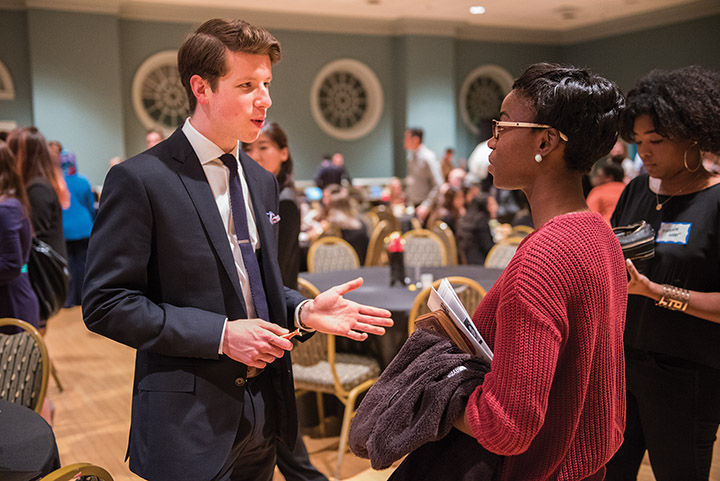
Senior communication major Efua Cudjoe (right) talks with Drew Blais, digital strategist at Van Eperen & Company, at the Grunig Gala in Stamp Student Union on October 20, 2015.
Communication students packed Stamp Student Union’s Colony Ballroom on Tuesday night to learn about their field — specifically, the public-relations disaster surrounding the Ebola crisis of the past year.
As part of the University of Maryland communication department’s eighth annual Grunig Gala, keynote speaker Kathy Lewton, a health care public relations and marketing executive, shared her expert view on the public-relations response to the deadly outbreak.
“The communication students here at the University of Maryland and in other colleges around the United States are going to be the public-relations team of such things in the future,” Lewton said. “I wanted to share with them what a disaster the Ebola crisis was, and how public relations could have prevented such a negative reaction to the entire thing.”
Six students on the Grunig organizing team put together the event to allow communication students to talk to professionals in their field and hear stories they can relate to.
Email was one major way public-relations firms and businesses communicated with one anther during the crisis, Lewton said, which isn’t always the best way.
“Email, although an effective tool, can hurt an organization — such as the Texas hospital who said that they could handle Ebola patients when they clearly did not have the training for these types of medical issues,” Lewton said.
Lewton added that the responsibility of public-relations teams is to make sure all messages are communicated clearly and effectively so circumstances don’t get as out-of-control and as scary as they did.
“When it was the black doctor who was not diagnosed with Ebola right away, and when he was, the media and people started to go crazy,” she said. “When the nurse who was infected with Ebola was outed to the world, the entire country was freaking out and thinking that they would get Ebola if they breathed the same air as the infected person.”
Jameson Roth, a junior communication and family science major, said she found the event informative because she is focusing her career path on health communication.
“I’m taking health communications right now, and one of the things that we touched on was whether statistical or narrative-based health care messages are coming across in the right way to our audiences,” Roth said. “Narratives touch more people, so hearing ways to overcome such issues in an event like this was a great way for me to understand what I need to do in my career.”
With more professionals speaking at 17 roundtables, the event also featured networking opportunities for students seeking career tips and offered chances to learn about mistakes and hear about successes in the communications world, said Alexandra Saltz, a senior communication major.
Roundtable speaker Melinda Machado, director of the public affairs office at the National Museum of American History, said she was glad to be at the event.
“I have been to many of these types of events, but never at the University of Maryland,” Machado said. “It was nice to be able to talk to students to ask them what they wanted to do with their communications degree and to also tell them how I learned from my mistakes as a public-relations person.”
Danielle Moore, a senior communication major, said the topic of Ebola really helped her understand more about how a simple email or communication error can create an uproar when people don’t understand what exactly is happening.
“This whole idea of learning from professionals and hearing [Lewton’s] lecture was something that would help me as I prepare to graduate from Maryland and understand what I can avoid doing in my job as someone a part of public relations,” Moore said.



